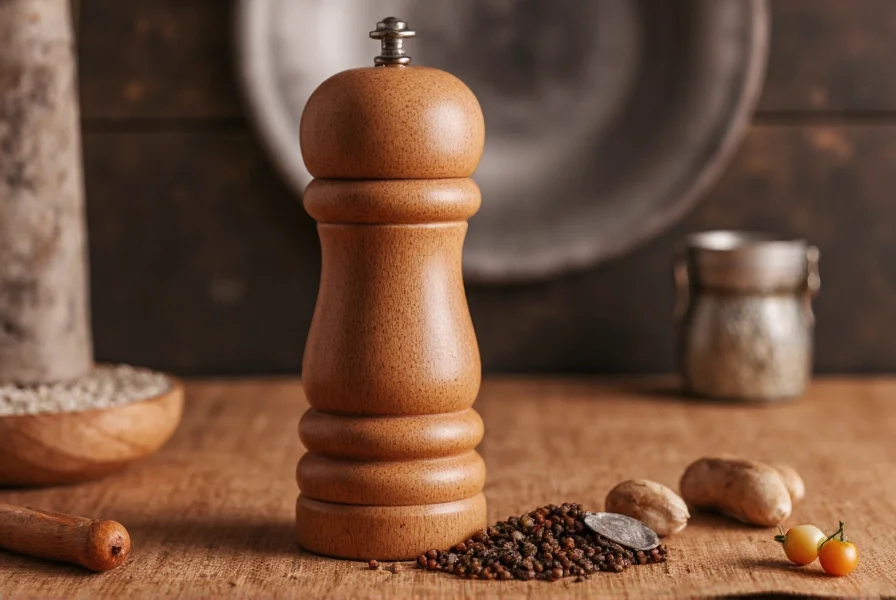Nothing transforms a dish like freshly ground pepper. While pre-ground pepper loses its volatile oils and flavor compounds within weeks, a quality pepper grinder delivers maximum flavor impact with every twist. Understanding the mechanics and varieties helps you select the perfect tool for your culinary needs.
How Pepper Grinders Work: Mechanism Matters
The heart of any pepper grinder is its grinding mechanism. Two primary types dominate the market:
| Mechanism Type | Best For | Lifespan | Maintenance Needs |
|---|---|---|---|
| Ceramic | Dry spices, salt (non-iodized), pepper | 10+ years | Low - resistant to corrosion |
| Stainless Steel | Pepper exclusively | 5-15 years | Moderate - requires occasional cleaning |
Ceramic mechanisms maintain sharpness longer and resist corrosion from salt, making them versatile for multiple seasonings. Stainless steel mechanisms provide exceptional durability specifically for pepper but can corrode if used with salt. The grinding action works through a series of precisely engineered burrs that crush peppercorns to your desired consistency.
Manual vs. Electric: Choosing Your Operation Style
Your preferred kitchen workflow determines whether a manual or electric pepper grinder suits you best:
- Manual grinders offer precise control over grind size and quantity. Turning the knob or twisting the top allows you to feel the grinding process and stop exactly when you've achieved your desired amount. They require no batteries or electricity, making them reliable kitchen staples.
- Electric grinders provide convenience with the push of a button. They're ideal for frequent cooking or those with limited hand mobility. Modern models feature adjustable grind settings controlled electronically, though they typically cost more and require battery replacement.
Consider your cooking frequency and physical needs when selecting between these operation styles. Professional chefs often prefer manual grinders for their precision, while home cooks with arthritis might benefit from electric models.
Key Selection Criteria for Quality Pepper Grinders
When evaluating potential purchases, focus on these critical factors that determine long-term satisfaction:
Adjustable Grind Settings
The best pepper grinder for kitchen use features multiple grind settings from fine powder to coarse cracks. Look for models with a simple adjustment mechanism—usually a knob at the bottom or top—that provides clear, consistent settings without slipping during use.
Build Quality and Materials
Pepper grinder durability depends on both the mechanism and housing materials:
- Glass - Elegant but fragile, best for display
- Stainless steel - Durable, modern, resists stains
- Wood - Traditional aesthetic, requires occasional oiling
- Acrylic - Affordable, lightweight, shows pepper level
Regardless of housing material, the internal mechanism quality determines performance longevity. Investing in a grinder with a ceramic or high-grade stainless steel mechanism pays dividends in consistent performance.
Ergonomics and Usability
A comfortable grip and smooth operation make frequent use enjoyable. Test grinders if possible—the turning action should feel smooth without resistance, and the size should fit comfortably in your hand. Larger grinders hold more peppercorns but may be cumbersome for small hands.
Maintenance Tips for Longevity
Proper care extends your pepper grinder's life significantly:
- Never expose to water - Most grinders aren't dishwasher safe. Wipe exterior with damp cloth only
- Clean mechanism periodically - Run uncooked rice through the grinder to clear residue
- Store properly - Keep in a cool, dry place away from humidity
- Refill correctly - Use whole peppercorns only; avoid pre-ground pepper
Ceramic mechanisms require less maintenance than steel, but both benefit from occasional cleaning. If your grinder becomes difficult to turn, it likely needs cleaning rather than replacement.
Common Misconceptions About Pepper Grinders
Several myths persist in the culinary world:
- "All grinders work the same" - Mechanism quality varies dramatically between budget and premium models
- "Salt and pepper grinders are interchangeable" - Only ceramic mechanisms handle both; steel corrodes with salt
- "Electric grinders are always better" - Manual models offer superior control and reliability
- "Price equals quality" - Some mid-range models outperform expensive designer brands
Understanding these distinctions helps you make informed decisions rather than relying on marketing claims.
Final Considerations Before Purchasing
Before adding a pepper grinder to your kitchen tools, consider your specific needs:
- How frequently do you cook with fresh pepper?
- Do you need one grinder for both salt and pepper?
- What's your preferred grind consistency for different dishes?
- Do you have physical limitations affecting manual operation?
The ideal pepper grinder balances performance, durability, and usability for your specific kitchen routine. Investing in a quality model ensures years of flavorful seasoning without the frustration of inconsistent grinding or premature failure.











 浙公网安备
33010002000092号
浙公网安备
33010002000092号 浙B2-20120091-4
浙B2-20120091-4